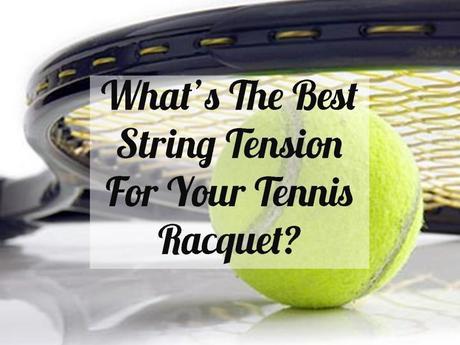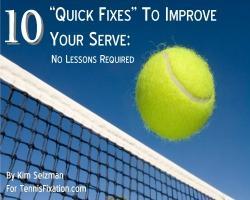Podcast: Play in new window | Download
Another episode of the Tennis Quick Tips podcast is here! In this episode, I’ll tell you all about getting the string tension exactly right for your tennis racquet and your style of play. You can listen to this episode by clicking on the gray media player above or by listening in with your favorite podcast app. You can also find it in iTunes by clicking on this link: tennisfixation.com/itunes.

TRANSCRIPT:
In last week’s podcast, I talked about a piece of equipment you may or may not use on your tennis racquet – the vibration dampener. In this episode, I want to talk about a piece of equipment you absolutely must use on your tennis racquet – your strings. Specifically, what I want to talk about is string tension.
For a lot of us, when we first started playing tennis, we just picked up an old racquet and started playing with it. I know that’s how it was for me. I used my husband’s tennis racquet for months before it occurred to me that maybe the racquet that my husband chose for himself wasn’t really the best racquet for me. And maybe, even if the racquet was okay for me to use, it wasn’t strung at the tension that best complemented my game. And let me be completely honest here – as much as I love tennis, it took months for these thoughts to occur to me. Yikes.
So don’t be me. Don’t just be playing along with your racquet and not be concerned about how its strung. Instead, make sure you’re racquet is strung at the tension that is exactly right for you. Here’s how to do that.
First off, ask yourself, just what tension is your racquet strung at? Do you have any idea at all?
Now, you may know exactly how your racquet is strung and you may be very happy with that and any discussion of “optimal racquet string tension” may not be of much use to you. But I’m guessing many of you don’t know anything at all about the tension of your strings. You just hand your racquet over to your stringer and say, “Just do whatever you did last time.”
And, while that’s okay, it also means that your racquet might possibly NOT be strung at the best tension for YOU. And, if, like me, you need all the help you can get on the tennis court, then you need to make sure you’re racquet is strung at the best tension for you and your game.
You probably know that your racquet has a tension range – the optimal range within which your racquet should be strung. If you don’t know that, you can easily find out the tension range for your racquet. Just look inside the throat of your racquet or somewhere on the frame. This is where you’ll find all of the specifications for your particular racquet. For my racquet, the range is “58 +/- 5 lbs.” This means, according to the manufacturer, the optimal tension range on my racquet is somewhere between 53 and 63 pounds.
So I’ve got a 10 pound range to work with. How do I know how tightly or loosely to have my racquet strung?
Well, there’s some physics involved here (what a surprise!) that you’ve got to understand in order to pick the tension that’s right for you. In general,
lower string tensions provide more power, a larger sweet spot and are easier on the arm, and
higher string tensions provide more control and spin.
Why is this true? Looser strings have more of a “trampoline” effect on the ball, sending it back with more energy. Less of the ball’s energy is absorbed by the strings and the strings sort of trampoline the ball back. This also results in less vibration and shock being sent through the racquet to your arm. And hopefully less tennis elbow. But because the strings are “deformed” more when loose, any slight change in racquet position can result in a bigger change in the ball’s direction on return. So your return shot may be less accurate.
Tighter strings do not deform as much, absorbing more of the energy generated by the collision between the ball and the strings and thus decreasing the amount of energy traveling back with the ball. So this means a less powerful shot. This collision also results in more vibration being transferred to the racquet and to your arm. Which can mean more tennis elbow. But because the strings do not change shape as much, because they’re not as “trampoline-y”, the direction of the ball is less apt to change. You get a more accurate shot. Got it?
You may already know what tension your racquet is strung at and you may be very happy with that and all of this talk of string tension physics may not be of much use to you. Except maybe for chatting up people around your tennis club or the stringers in your pro shop.
But, if you don’t know about your string tension, what you SHOULD do is spend a little time, and probably a little money, figuring out the best string tension for you. You can do this by starting with having your racquet strung at the midpoint of its tension range. On my racquet, for example, that would be 58 pounds, and that is exactly where I had it strung for the first time after I bought it. Play with that for a while, see how it feels and then, based on the physics I’ve explained, consider increasing or decreasing the tension a little to get your racquet to play in a way that is best for you. You know if you want to generate more power with looser strings. You know if you want more control on your shots with tighter strings. Your racquet stringer may not know anything at all about what you want or how you play your game. However, having said that, don’t be afraid to talk to your stringer about that stuff – that discussion should be part of their job. After you make this change, play with this new tension and see what you think. It should only take you one or two string jobs to come up with the tension that works best for you.
And finally, here’s my bonus tip, if you’re going to all of this trouble, write down somewhere what type of strings you’re using and what tension your racquet is at so that you’ll know what to ask for the next time you take it in for restringing.
In the show notes to this episode, which you can find at tennisfixation.com/quicktips34, I’m going to put links to several useful Tennis Quick Tips episodes. I’ll have a link to Episode 13 about what kind of tennis string you should use, and Episode 15, on preventing and treating tennis elbow. So check out the show notes to get that information.
RESOURCES AND LINKS FROM THIS EPISODE:
What Kind Of Tennis String Should You Use – Tennis Quick Tips Podcast Episode 13
How To Prevent And Treat Tennis Elbow – Tennis Quick Tips Podcast Episode 15
SHARE THIS EPISODE:
If you enjoyed this episode, or know someone who might, please feel free to share it with them. You can simply direct people to:
http://tennisfixation.com/quicktips34
There are also sharing and email buttons at the bottom of this post.
SUBSCRIBE:
I hope you’ll subscribe to the Tennis Quick Tips podcast so you can listen in just as soon as each episode is released:
- SUBSCRIBE IN iTUNES: Visit the TQT iTunes page and subscribe (click on the “Subscribe” button or the blue “View in iTunes” button) or search for “Tennis Quick Tips” in the iPhone Podcast app.
- SUBSCRIBE ELSEWHERE: Search for “Tennis Quick Tips” in your favorite podcast app. Or visit the TQT Stitcher page and subscribe.
- Or visit the TQT podcast feed URL and listen in.
Thanks for listening and, as always, Happy Tennis!

© Kim Selzman 2014 All Rights Reserved 650 ? 650: true);" class="ois_box_14 container-fluid">If you enjoyed this article . . .There's plenty more!Sign up for FREE Tennis Fixation Weekly Updates and you'll receive my FREE eBook "10 Quick Fixes To Improve Your Serve: No Lessons Required!"



